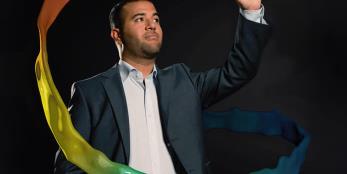Covestro and Crystal IS explore impact of UVC disinfection on polycarbonate materials
Pittsburgh, September 1, 2020 — Ultraviolet C (UVC) light, which is already widely used for disinfecting water, is also increasingly used to disinfect surfaces. UVC has a potent germicidal effect against bacteria and viruses, and with the COVID-19 pandemic, many industries are looking for new ways to sanitize products, such as medical equipment, car interiors and consumer electronics. Because disinfection can have an impact on some materials, it’s important that engineers and designers choose materials that are able to retain their physical and aesthetic properties — even after repeated UVC disinfection.
Together with Crystal IS, the world’s leading manufacturer of UVC LEDs, Covestro is investigating the influence of UVC disinfection on polycarbonate-based materials. Plastic parts were exposed to a total dose of 120 J/cm2 of UVC, which corresponds to several thousand disinfection cycles for hospital equipment or automotive interiors, over many years of use.
These first tests measured color shift and aesthetic changes in the plastic parts, and the results mainly depended on the starting color. Black-colored products showed a color shift (delta E) of less than 1 after UVC exposure, imperceptible to most observers. Among others, an example of this was Bayblend® T85 XF PC+ABS blend, which is widely used in automobile interiors.
Transparent Makrolon® polycarbonate yellowed slightly, with a delta E of 3, noticeable only upon close inspection. White and gray materials in the Makrolon®, Bayblend® and Makroblend® product families showed more yellowing. However, it was limited to the surface of the parts, with the rest unaffected. In all parts, the surface gloss of the materials was retained after UVC exposure.
“As disinfection techniques are increasingly sought after in automotive applications, we’re helping OEMs and designers identify material solutions that meet these growing needs,” said Rudy Gorny, senior principal scientist – Mobility at Covestro LLC.
“Through our initial testing with Crystal IS, we found that Bayblend® PC+ABS blends and Makrolon® polycarbonate may work well for applications that undergo UVC disinfection,” said Paul Nowatzki, senior product expert – Healthcare at Covestro LLC. “We look forward to expanding this investigation.”
"UVC LEDs are enabling the development of innovative on-demand solutions to help prevent the spread of COVID-19 and other pathogens,” said Larry Felton, president, Crystal IS. “Understanding and quantifying the impact of UVC on materials used in products for medical, automotive and other solutions is a key step toward ensuring these designs can be deployed safely, reliably and at a low cost.”
Covestro and Crystal IS are now studying the influence of prolonged UVC exposure on physical properties such as heat resistance, tensile strength and impact resistance. The companies seek to collaborate with leaders in the electronics, automotive and healthcare industries to further this ongoing investigation.
About Covestro LLC:
Covestro LLC is one of the leading producers of high-performance polymers in North America and is part of the global Covestro business, which is among the world’s largest polymer companies with 2019 sales of EUR 12.4 billion. Business activities are focused on the manufacture of high-tech polymer materials and the development of innovative solutions for products used in many areas of daily life. The main segments served are the automotive, construction, wood processing and furniture, electrical and electronics and healthcare industries. Other sectors include sports and leisure, cosmetics and the chemical industry itself. Covestro has 30 production sites worldwide and employed approximately 17,200 people at the end of 2019.
Find more information at www.covestro.us or www.solutions.covestro.com/en/materials/plastics.
About Crystal IS:
Crystal IS, an Asahi Kasei company and ISO 9001:2015 certified, is a pioneer in the development and commercialization of Aluminum Nitride substrates. Aluminum Nitride’s wider bandgap capability means that devices grown on Aluminum Nitride can more effectively (technically and economically) emit at the deeper ultraviolet (UVC) wavelengths than devices grown on sapphire. Crystal IS products are used to produce high performance UVC LEDs for environmental monitoring and disinfection in a variety of applications that enhance and sustain life and living around the world. For more information, visit www.cisuvc.com.
Bayblend®, Makrolon® and Makroblend® are registered trademarks of Covestro Group.
Covestro Contact:
John Skabardonis, Phone: +1 412 413 5444
John.Skabardonis@covestro.com
# # #
This news release may contain forward-looking statements based on current assumptions and forecasts made by Covestro AG. Various known and unknown risks, uncertainties and other factors could lead to material differences between the actual future results, financial situation, development or performance of the company and the estimates given here. These factors include those discussed in Covestro’s public reports which are available at www.covestro.com. The company assumes no liability whatsoever to update these forward-looking statements or to conform them to future events or developments.
Editor’s Note: Follow news from Covestro on Twitter:
www.twitter.com/CovestroUS







